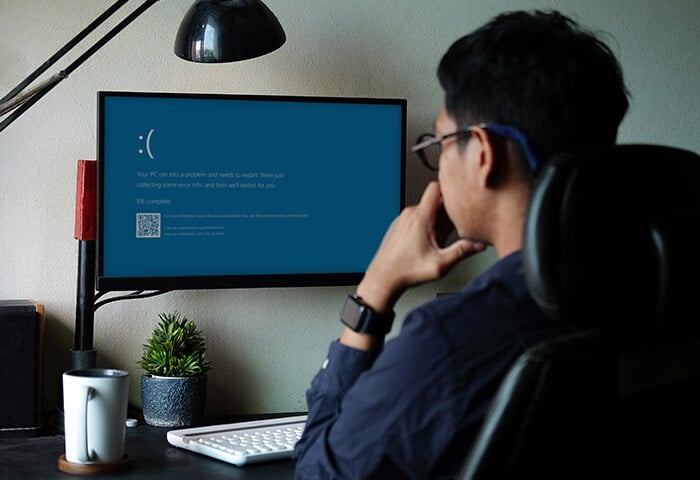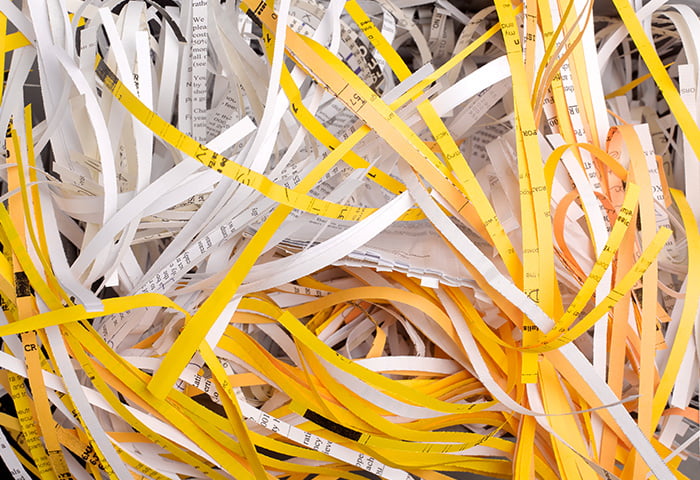What is bloatware?
Bloatware is software that uses up resources without doing anything useful. Many device manufacturers can lower their prices by pre-installing this type of software, but the flip side is that your device comes riddled with apps that take up valuable device space and resources.
Bloatware can hijack your browser, automatically change settings, and lead to security exploits and, ultimately, a more vulnerable device. Bloatware usually deserves the same response as malware: get rid of it immediately.
Here are some types of pre-installed bloatware to look out for:
-
Adware: Adware delivers ads to your screen with pop-ups and creates desktop shortcuts to product pages. These are intrusive and unpleasant while also taking up resources and slowing you down.
-
Toolbars: Next time you open Firefox or Edge, you might see a strange toolbar under the web address that promises unique functionality. You don’t need this; many browsers come stacked with basic features, like settings to delete browser cookies. Not to mention, browsers already use a ton of RAM without these useless toolbars.
-
Trialware: Your PC might come with free trials of software you never planned on using. Once the free trial runs out, you’ll be bombarded with ads prompting you to buy a subscription to the app you didn’t willingly install in the first place.
-
Utility apps: These are like off-brand versions of tools you do use. They usually don’t work as well as the popular tools you’re already familiar with, but they can sometimes be helpful if you don’t plan to upgrade to premier programs just yet.
How can bloatware impact your device?
Bloatware slows down your device, making it harder to use. As software that’s been dumped onto your PC or phone by the manufacturer to save a buck, it’s almost never something you’d download willingly.
A new device may run slower than you expect if it’s wasting resources on programs you don’t need. And it’s not just that. These bloatware programs can bombard you with ads — and a more inexperienced user might be misled into buying even more unnecessary software.
Some programs are just useless, and some actively make your experience worse. A good rule of thumb is to remove any programs you aren’t using. So take control of your device immediately by clearing out bloatware upon initial setup — it’s one of the best ways to avoid negative device impacts.
How to identify bloatware?
On Windows, you can identify bloatware by going to Start > Add or Remove Programs and then scrolling through the list of installed programs. On Mac, Android, and iPhone, open your list of installed apps. Check for bloatware that might contain the manufacturer's name, or an unfamiliar brand name.
Next, ensure the program you want to uninstall actually is bloatware by Googling it first. You can also use a dedicated bloatware removal tool to do the work for you.
 AVG TuneUp’s statistics dashboard, summarizing its monthly PC optimizations.
AVG TuneUp’s statistics dashboard, summarizing its monthly PC optimizations.
Knowing what qualifies as bloatware requires a bit of computer know-how, which can take time. AVG TuneUp can help you track down and uninstall unnecessary software with the click of a button. It even works beyond bloatware removal, providing 24/7 maintenance to clear out the junk on your computer and help it run faster for longer.
How to remove bloatware?
Removing bloatware works differently on different devices, but it generally involves finding the method to uninstall programs and picking out the bloatware. It’s one of the best ways to clean up and speed up your PC.
Here’s how to remove bloatware on various devices:
How to remove bloatware on Windows 11 and Windows 10
Thankfully, the basic process for removing Windows 11 bloatware and removing bloatware from Windows 10 is the same. You don’t have to get used to new settings menus or anything like that.
That means you can safely follow these instructions whether you’re trying to learn how to remove bloatware from Windows 10 or hoping to get rid of pesky Windows 11 bloatware. Here’s how to do it:
-
Hit the Windows key and type Add or remove programs in the search bar. Hit Enter.

-
Review the list of apps and look for anything you don’t recognize. When you think you’ve spotted bloatware, Google it to learn what kind of program it is. If the Google results say it’s an essential program or process, don’t uninstall it. If the results say that it’s a data recovery, productivity, or program you don’t need right now, continue to the next step.

-
Click the program and select Uninstall.

The app might sound useful when you Google it, and you might occasionally need certain types of software, such as one that clones your hard drive. But you likely don’t need every program you’ll use to sit on your computer 365 days a year.
There you have it — now you know how to remove bloatware from Windows 10 and 11.
Keep in mind that in some cases, computers automatically reinstall bloatware on every reboot. Getting around this requires expert-level knowledge, and it’s not advised to try this yourself. Remember, you can always fall back on specialized apps to remove bloatware from Windows 10 and 11 for you.
How to remove bloatware from Android
Here’s how to remove bloatware on Android:
-
Get to Quick Settings by swiping down from the top of your phone. You may need to do it twice to see the whole Quick Settings panel. Tap Settings (the gear icon), then choose Apps.

-
Scroll through your list of installed apps. Select an app and tap Uninstall or Disable. Some apps can only be disabled, which is good enough for Android bloatware, while essential Android apps can’t be disabled or uninstalled.

It’s good to know how to remove bloatware from Android so your phone doesn’t slow down. You can also learn how to hide apps on Android if you just want it to look neater. There’s nothing like a little spring cleaning!
How to remove bloatware from Mac
Once again, it’s all about going to the list of programs you’ve installed and getting rid of the ones that don’t offer anything useful.
Here’s how to remove bloatware from your Mac:
-
Open the Applications folder. Review your installed applications. Right-click the app you identified as bloatware and select Move to Trash.

-
Click the Trash icon in the corner of your Dock.

-
Click Empty in the top-right corner of the Trash window.

While you’re at it, consider cleaning your Mac in other ways.
How to disable bloatware on an iPhone
The iPhone has a lot of features to help you make the most of your space. Thanks to the iPhone’s robust security, space and device efficiency are typically the main concerns.
Here’s how to get rid of bloatware:
-
Open iOS Settings and select General. Tap iPhone Storage.

-
From here, tap Enable next to Offload Unused Apps, and you’ll automatically gain a lot of space. Or, scroll through your installed apps and tap an individual app you want to uninstall. If you need to, you can easily download these apps again.

-
From there, you can offload the individual app so it stops taking up space on your phone. You can also remove the app entirely — permanently deleting all the data associated with it.

If you’re in the habit of playing free games, make sure to delete them once you’re done to free up mobile resources. Workplace training apps can also go in the trash if you don’t need the information anymore. You can also hide apps on the iPhone without deleting them. This can make your home screen a lot cleaner.
Examples of bloatware apps
To give you a better idea of what’s bloatware and what isn’t, here are some examples of what bloatware apps usually look like:
-
Productivity or focus apps
-
Messaging apps that none of your friends or family use
-
Cheap, free, or off-brand games
-
Game centers that aren’t Xbox Live, Steam, or Epic Games
-
Music or video apps that you didn’t download
-
Finance apps or built-in widgets
-
Toolbars or browsers you’ve never heard of
-
Some manufacturer apps that come pre-installed on new devices
Note that you need to be careful with manufacturer apps. Those can range from poorly made nuisances to expertly crafted tools that bring the best out of your device — sometimes, gaming computers are boosted with the latter. For example, ASUS’s Armoury Crate manages resources in a streamlined way, so any customer can boot up and start running Starfield without much fuss. Don’t get rid of that.
The rest should be easier to judge. Once you start learning more about your computer or phone, you’ll get a feel for what’s normal or useful and what isn’t. You’ll see a list of apps, a strange one will stand out to you, and you’ll immediately ask yourself, “What is that?”
Before you reach that level, refer to the descriptions above. Check for anything you didn’t download yourself, and Google it to make sure it isn’t something important.
Get rid of bloatware with AVG TuneUp
As long as you’re buying computers and phones, bloatware is something you’ll have to deal with. It’s one of the first things to take care of when setting up a new device. Fortunately, it doesn’t have to be a ton of work with AVG TuneUp.

AVG TuneUp can help target known bloatware and uninstall it in seconds. Not only does this pay off in dividends, but the app keeps up device maintenance long after by helping to update programs automatically, optimize your file system, and delete all kinds of junk files. Try AVG TuneUp for free today.

 AVG TuneUp’s statistics dashboard, summarizing its monthly PC optimizations.
AVG TuneUp’s statistics dashboard, summarizing its monthly PC optimizations.














/AVG-How-to-clear-cache-on-your-Mac-Thumb.jpg)





%20and%20how%20to%20remove%20them%20(Signal)/Signal-What-is-a-PUP-Thumb.jpg)
/Signal-The-best-cleaning-software-for-Mac-Thumb.jpg)



